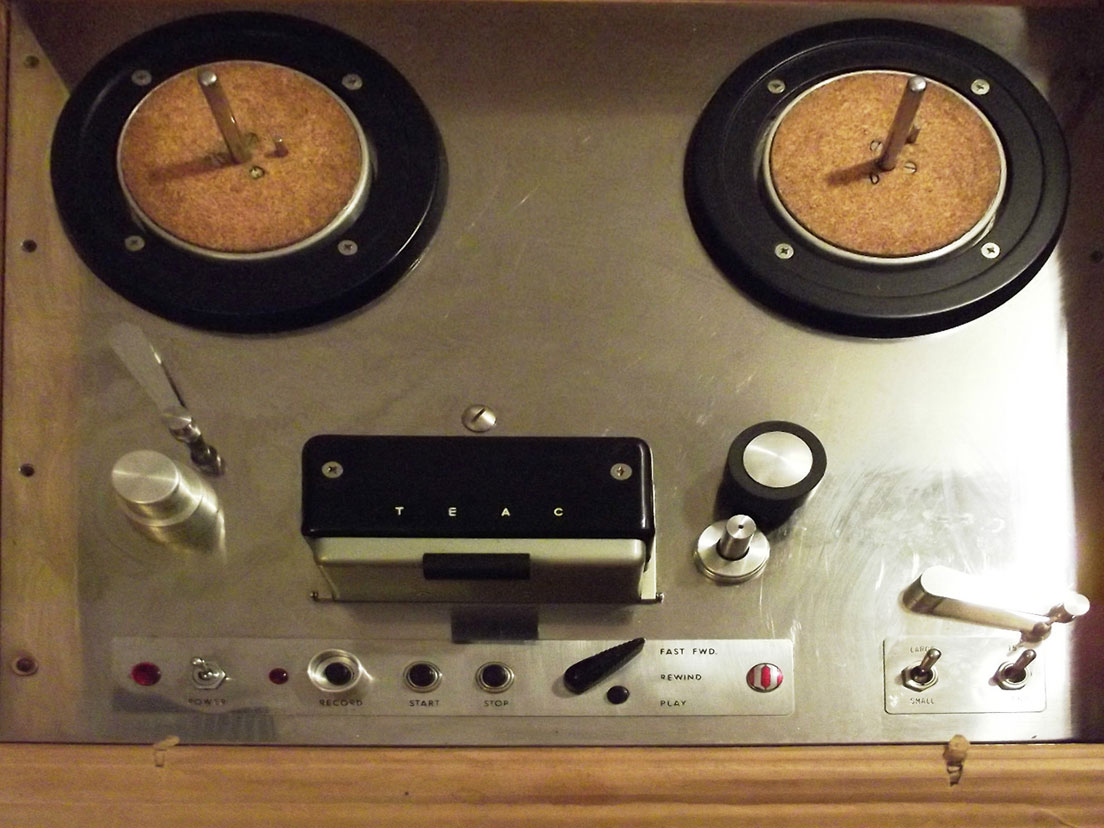
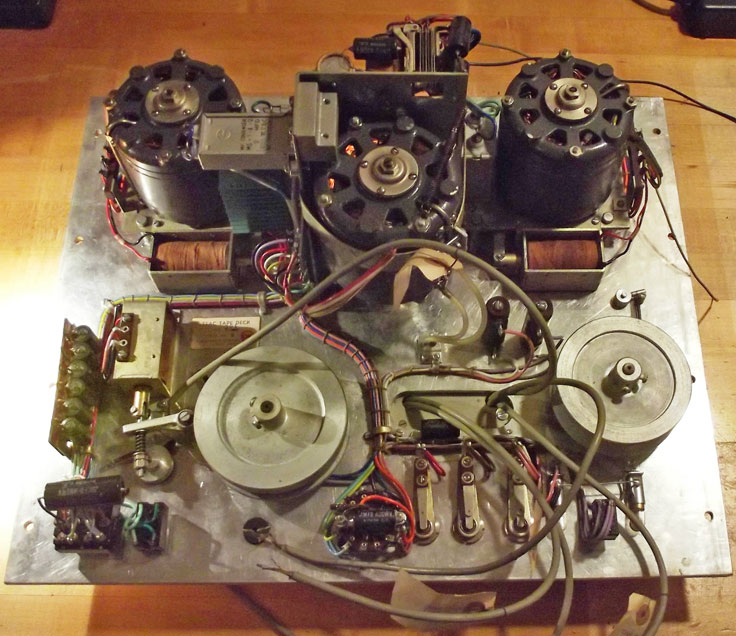
Teac TD-102 reel tape recorder - new in original shipping box from Japan
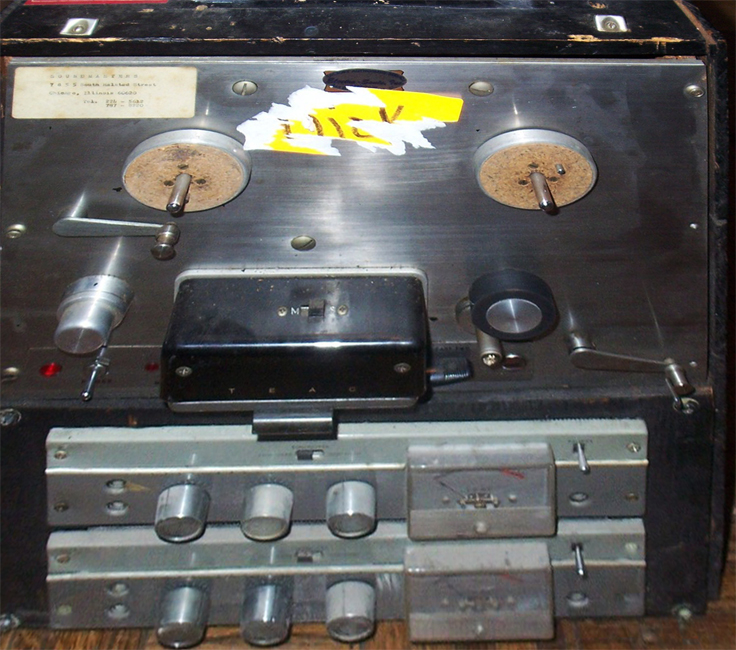
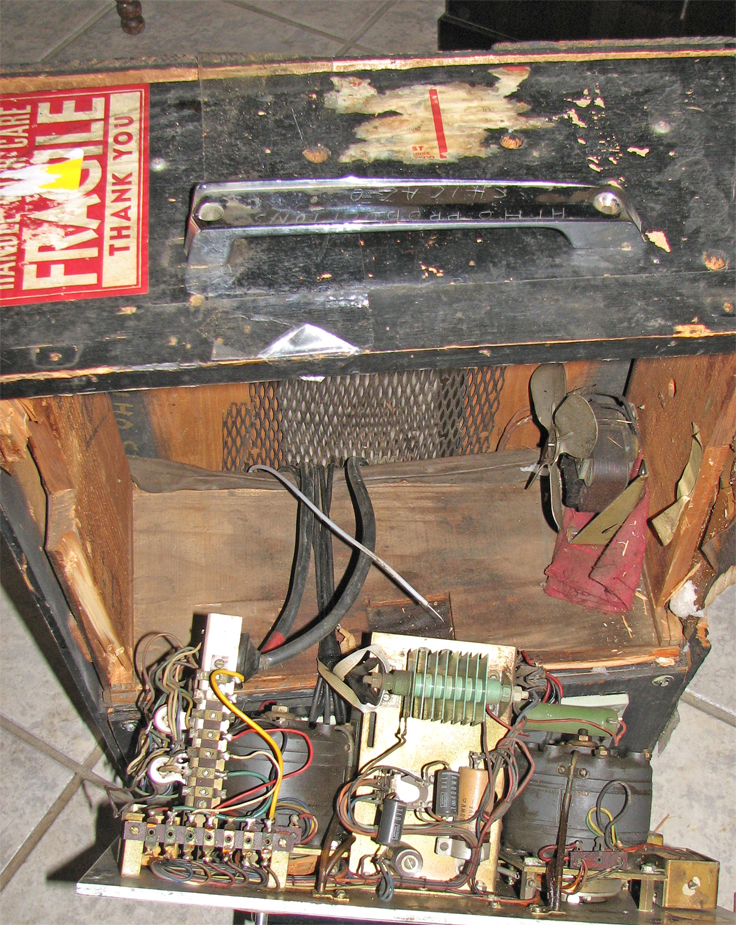
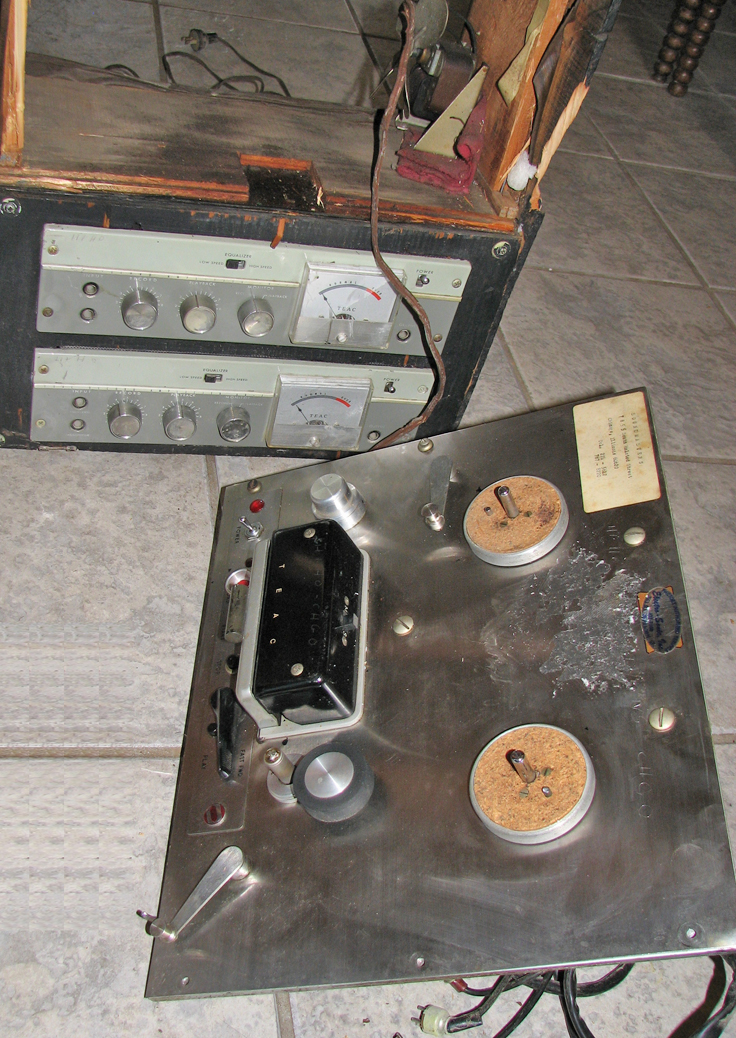
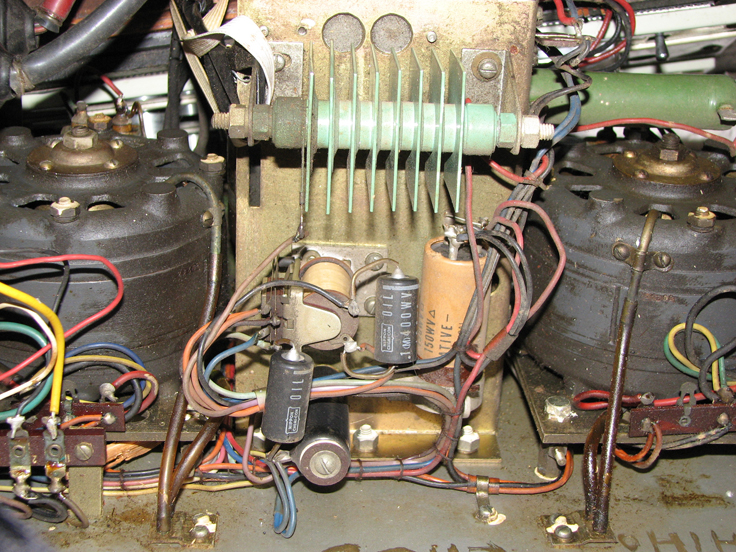
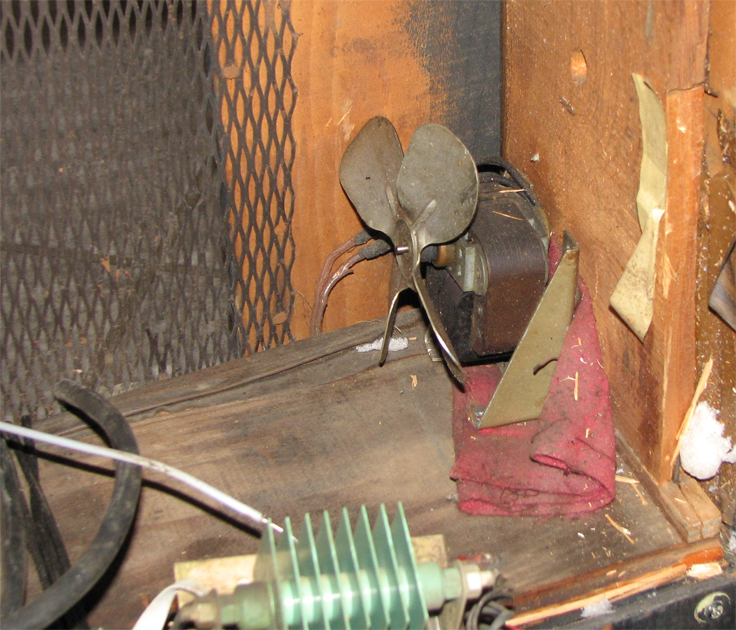



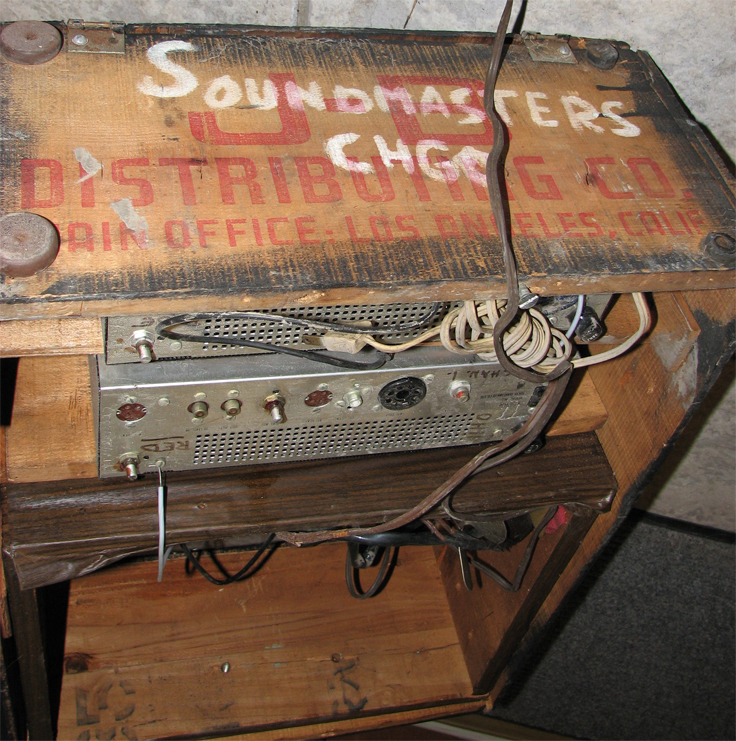
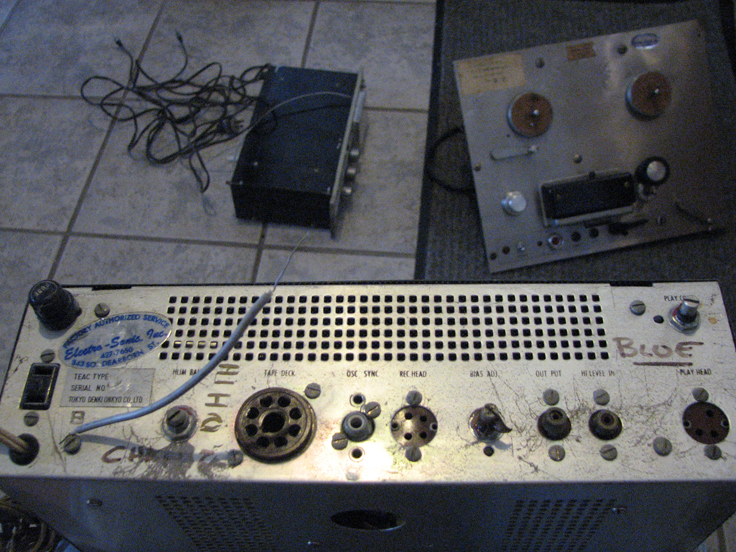
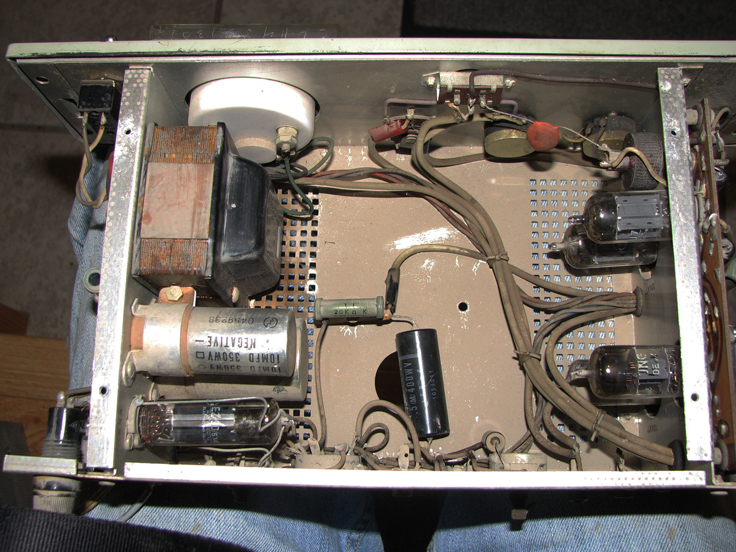
The Museum also has a working Teac TD-102 that came from Chicago Sound Masters company. It is a bit newer deck than the one above and has the original Teac preamps. The recorder was built into a wood box with an old refrigerator handle on top and a fan built into the bottom right corner for additional cooling. The recorder and its box have numerous labels stating the unit belongs to Sound Masters (even the refrigerator handle). Looks to have been a recorder that was on the go.
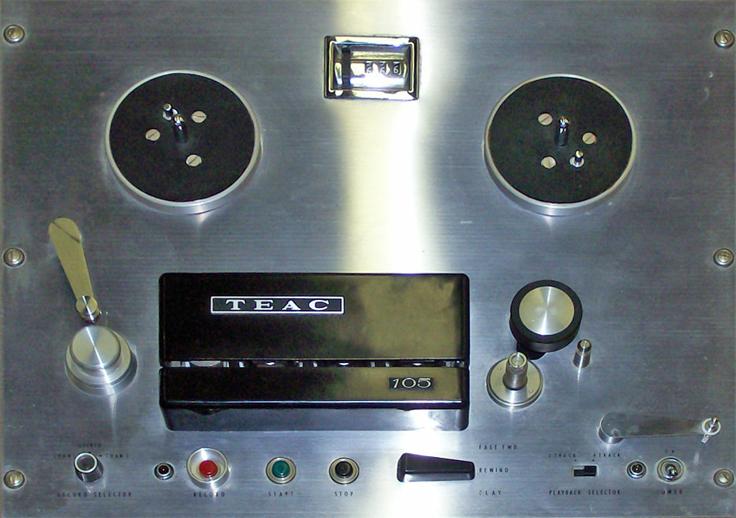
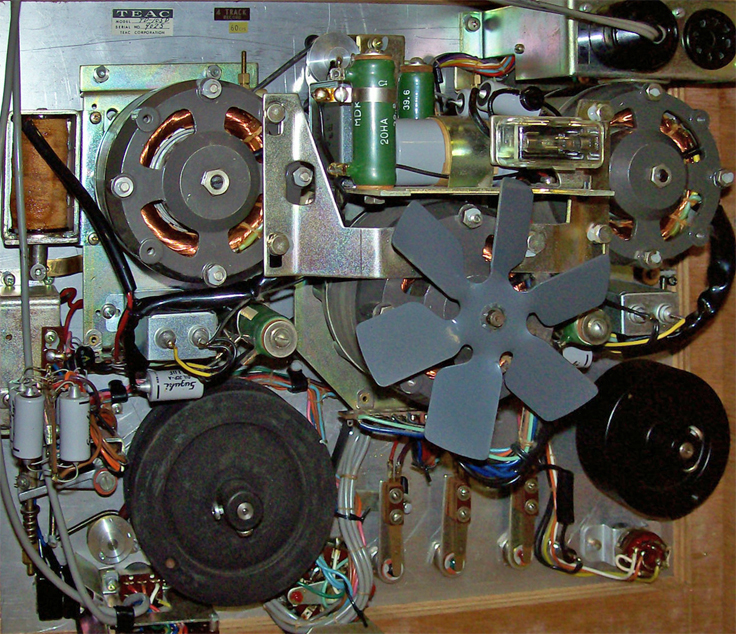
Teac TD-105 reel to reel tape recorder
TEAC/Concertone
Teac's relationship with the American Berlant Concertone reel tape recorder company led to Teac building components for several different reel to reel tape recorder manufacturers
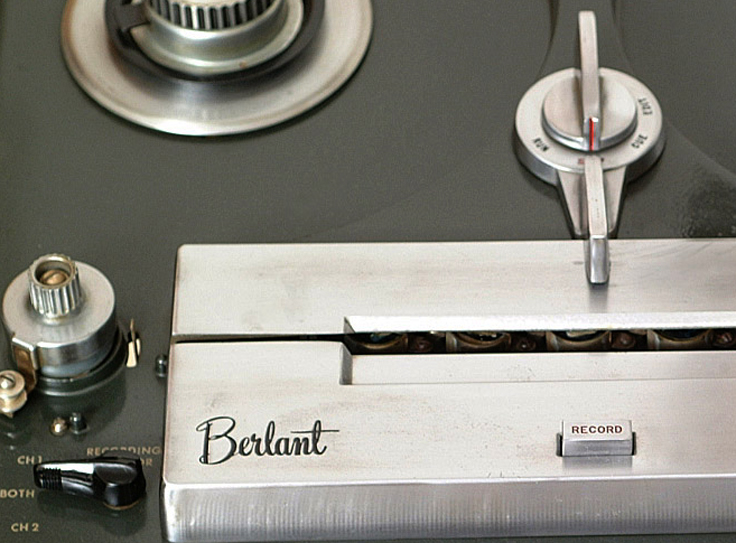 It probably seems unusual to begin this segment on Teac mentioning the Berlant Concertone recorder. Emmanuel "Bert" Berlant began manufacturing the Berlant reel to reel tape recorders in the late 1940's. Later his company Berlant and Associates introduced the Concertone line. His partners continued the company when Berlant left in 1956. Interestingly, that same year 2 brothers in Japan Tomoma & Katsuma Tani had
It probably seems unusual to begin this segment on Teac mentioning the Berlant Concertone recorder. Emmanuel "Bert" Berlant began manufacturing the Berlant reel to reel tape recorders in the late 1940's. Later his company Berlant and Associates introduced the Concertone line. His partners continued the company when Berlant left in 1956. Interestingly, that same year 2 brothers in Japan Tomoma & Katsuma Tani had 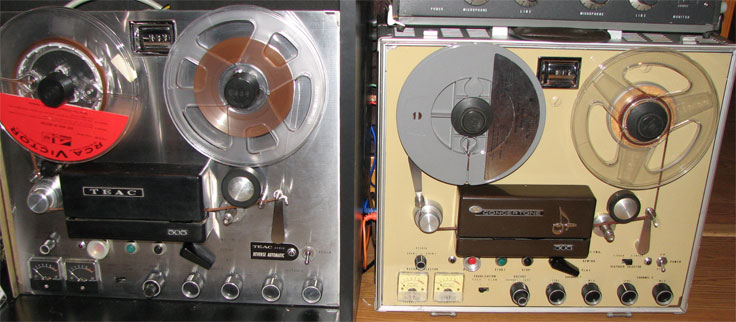 acquired a homemade 3 motor, 3 head stereo tape recorder and decided they could build a higher quality product. In December of 1956, the brothers formed the Tokyo Electro-Acoustic Company (TEAC) and began producing their early reel to reel tape recorders. In June 1959 the Tokyo Television Acoustic Co. and Tokyo Electro-Acoustic Co. join forces to manufacture tape recorders.
acquired a homemade 3 motor, 3 head stereo tape recorder and decided they could build a higher quality product. In December of 1956, the brothers formed the Tokyo Electro-Acoustic Company (TEAC) and began producing their early reel to reel tape recorders. In June 1959 the Tokyo Television Acoustic Co. and Tokyo Electro-Acoustic Co. join forces to manufacture tape recorders.
Sometime between 1957 and 1960, Berlant and Associates began buying Teac tape transports for their Concertone line of recorders. By 1960, the Concertone recorder assembly was moved to the Teac plant in Japan. The first time we saw an ad for American Concertone was in this 1959 ad for the Model 60, 63K and 68 (below).
The only mention of this move was found in the February, 1982 issue of Modern Recording and Music magazine. James Rayton with the Ascot Recording Studio in Hollywood, CA wrote: "probably around the early '60s, the (Berlant/Concertone) assembly was moved to Japan, and around the same time, I believe, the company became known, paradoxically, as "American Concertone"; their product emphasis gradually moved into the mid-to-high-end consumer category, (and occasionally appeared under other trade names like 'Concord'). Whatever remains of the company today is perhaps better known as TEAC, who interestingly, continued making the old Con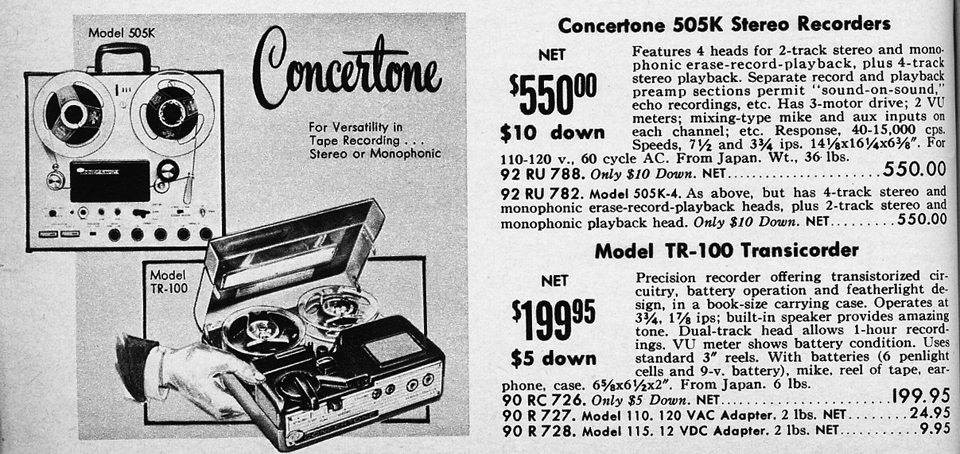 certone 90 at least through the late '60s, with only a change of nameplate (and probably solid-state electronics) and a different model number."
certone 90 at least through the late '60s, with only a change of nameplate (and probably solid-state electronics) and a different model number."
I believe the American Concertone 60 series (Concertone Electronics and Teac transports) evolved into the Concertone 505K, seen in this 1961 ad (right) with the model TR-100. The specs and design of the Concertone 505K and the Teac 505 are identical.
The earliest Teac reel to reel tape recorder in our collection is the 1956 Teac TD-102 reel to reel tape recorder. Next is the 1960 Teac 505R reel to reel tape recorder. An identical unit was built by Teac and labelled with the Concertone brand, which is also labeled the 505K. We have that unit in our collection as well (above right with the Teac 505 tape recorder).
In January 1961 the Corporate headquarters moved to the present site at 1-47 Ochiai, Tama-shi, Tokyo 206-8530, Japan.
In My 1961 a licensing agreement is concluded with IBM. First production in Japan of magnetic tape memory systems. 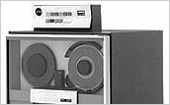
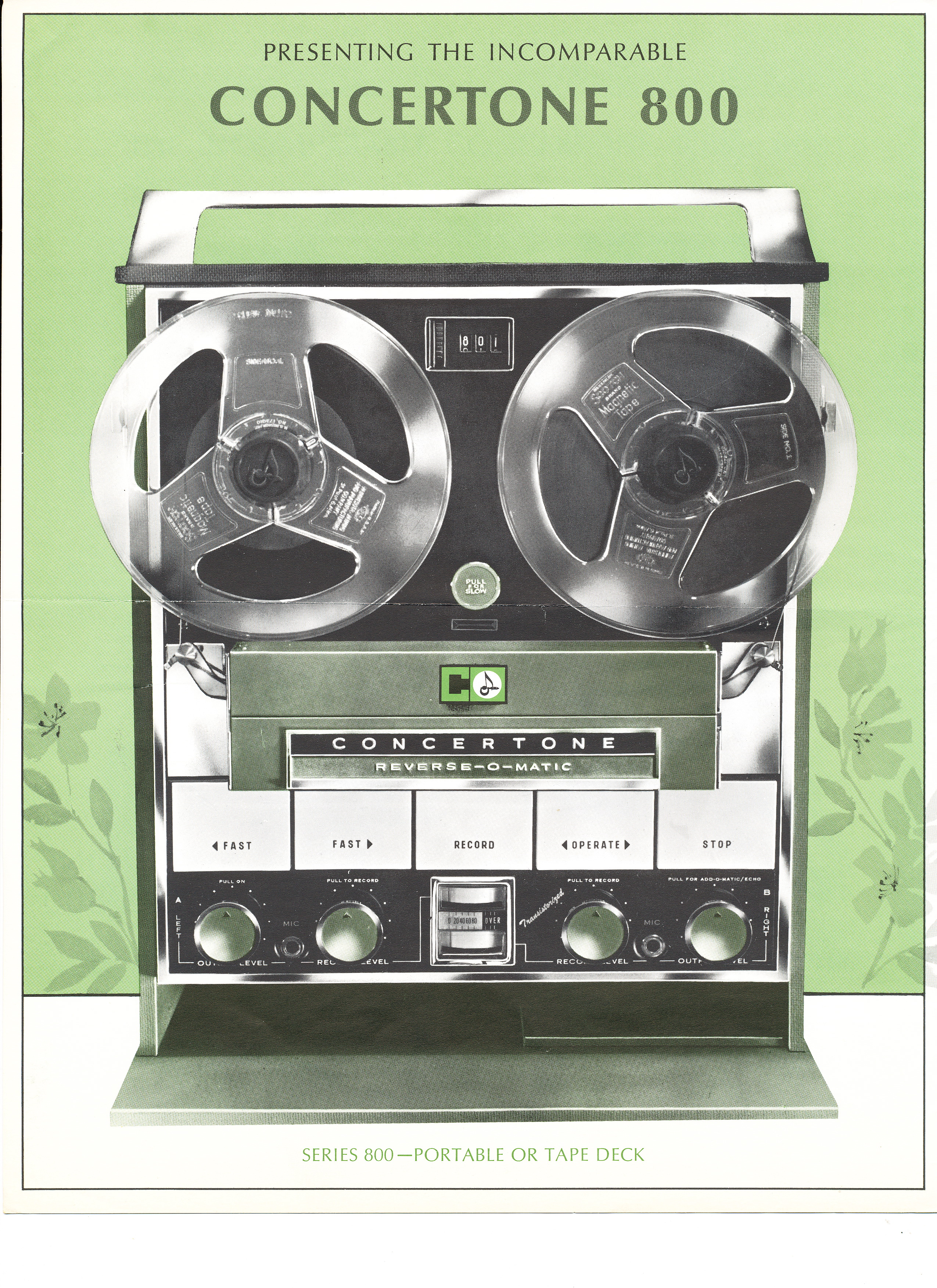
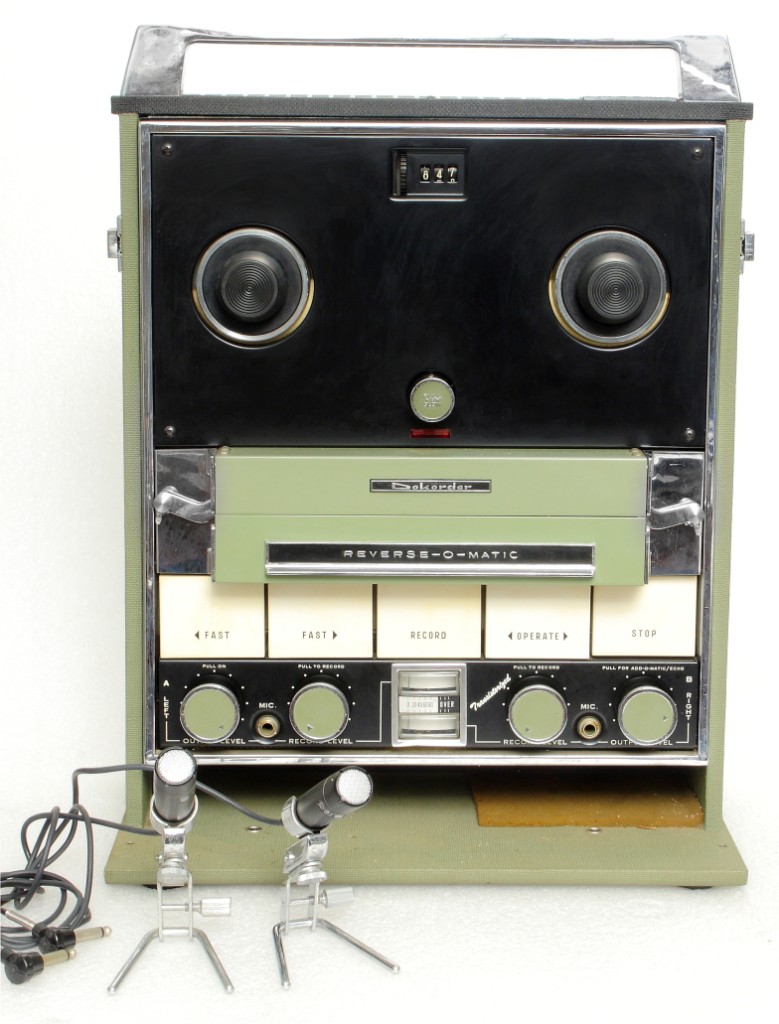
No Teac reel tape recorders were officially imported into the States until middle to late 1965. However Concertone was selling their recorders in the US under the American Concertone brand. Interestingly here is the Concertone 800 from 1964 (left). And here is the same recorder branded under the Dokorder brand right).
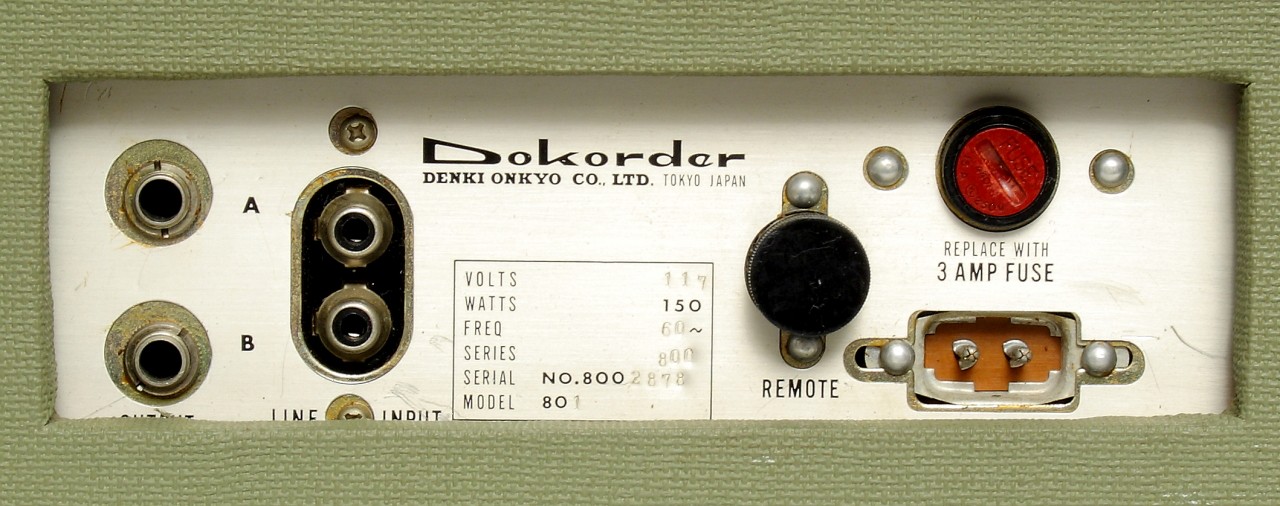
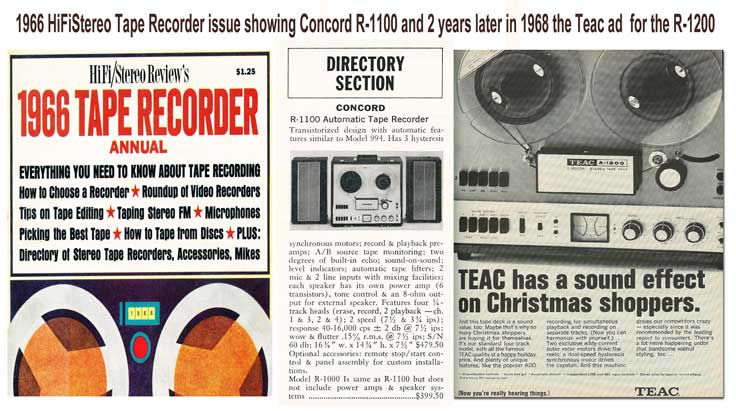
Teac/Concertone/Concord
Concertone, using the Japanese Teac facilities was also building Concord reel tape recorders. Here's the Concord R-1100 tape recorder listed in our 1966 Hi/FiStereo Tape Recorder Directory and one year later the same model being released in an ad for the Teac A-1200
No US Sales of Teac until 1965
Sales of Teac recorders were booming in the 1960's, however for persons in the US, they were only available to military folks through US base exchanges. There were no Teac reel to reel tape recorders released prior to 1965. The US government began requiring that offshore audio manufacturers to have US based service centers.
This gets interesting now because Teac continued to release reel to reel tape recorders and some may be branded only Teac and others may be Teac/Tascam or just Tascam
1966 Teac Professional Open Reel Tape Recorder Ads

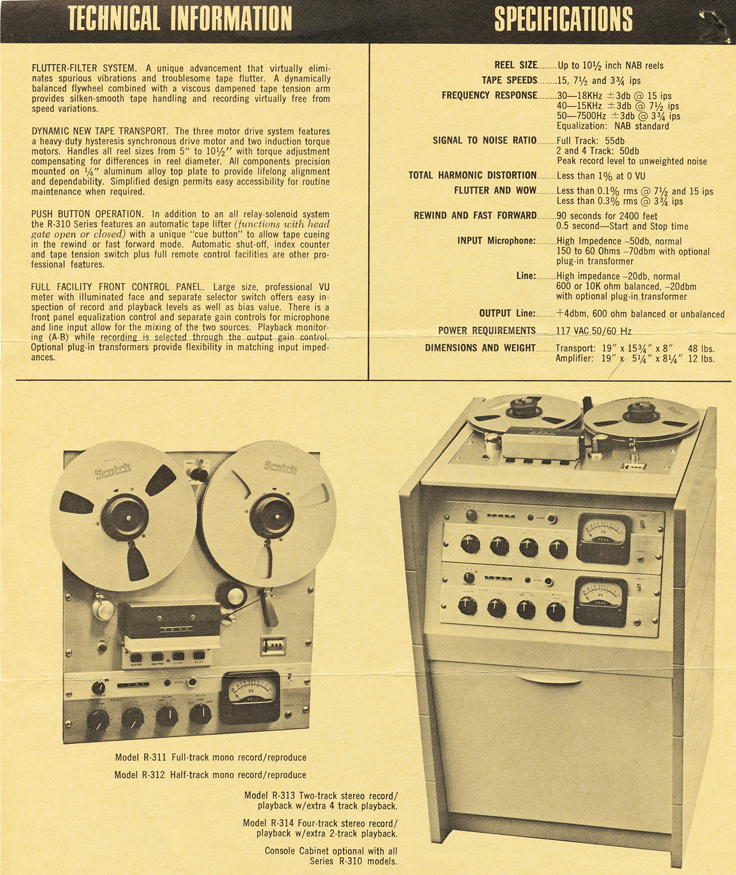

Tascam 
Around the middle to late 1965, according to the Tascam book, 30 Years of Recording Evolution, the US government required electronic imports to set up US based service facilities. The one set up for TEAC was located in Santa Monica, CA and named TCA for Teac Corporation of America. Here they began retrofitting the Japanese stereo and quad decks for multitrack and Simul-Sync recording.
In the late 1960's, the Tani brothers and Dr. Abe Yoshiharu, a senior engineer at TEAC, formed a special R&D group named TASC (TEAC Audio Systems Corp.) for the purpose of researching ways to apply TEAC's recording technology for musicians and recording studios. TASCAM (TASC America Corp.) was established in 1971 for the purpose of distributing TASC products in the U.S. and conducting additional market research. The company's first home was at 5440 McConnell Avenue, on the west side of Los Angeles near Marina del Rey.
 Dr. Yoshiharu Abe (03/31/1931 01/02/2013) - is known as the father of personal multi-track recording in the audio engineering field. He was one of the five founders of TEAC in 1957 and went on to become one of the company’s most important product designers.
Dr. Yoshiharu Abe (03/31/1931 01/02/2013) - is known as the father of personal multi-track recording in the audio engineering field. He was one of the five founders of TEAC in 1957 and went on to become one of the company’s most important product designers.
In the may 30, 1970 Billboard, Teac said they were the largest manufacturer of 3 motor reel tape decks, turning out 9,00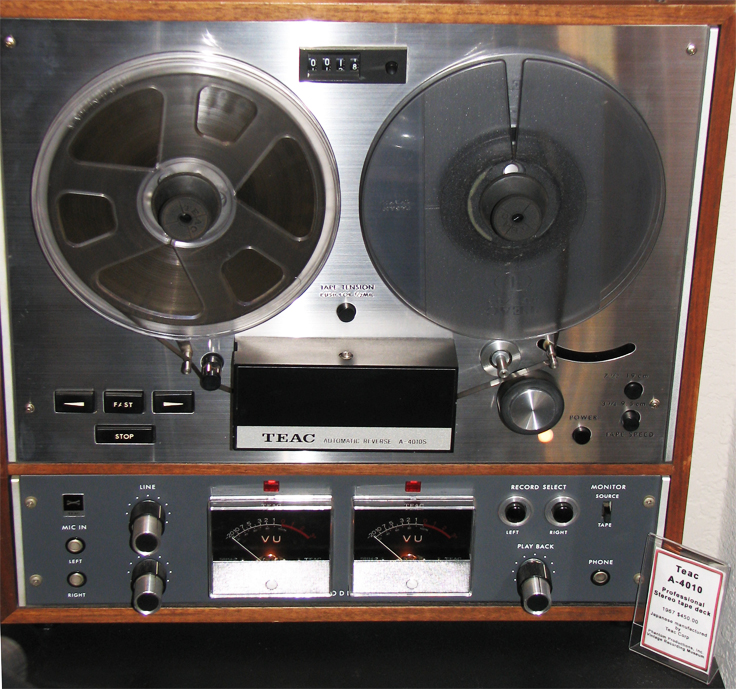 0 units per month.
0 units per month.
During the formative years in the early '70s, the music scene was flourishing. Musicians who wanted to showcase their talents and abilities to the recording industry needed a cost effective means to record their music. However, most musicians could afford neither the expense of recording in a professional recording studio nor the asking price of professional recording equipment. Realizing the dilemma facing these musicians, TASC adopted a philosophy of manufacturing recording equipment that offered the uncompromising quality and durability of professional studio equipment while remaining affordable to the masses.
The early TASC multitrack products were sold under the TEAC brand name. In 1974 TASCAM was absorbed by the rapidly growing TEAC Corp. of America sales and distribution company, and TASCAM became the official brand name of all TEAC recording products designed specifically for musicians and recording studios.
1971 TASCAM (TASC America) created by Teac Audio Systems Corporation (TASC) of Tokyo and headed by Dr.Yoshiharu Abe and a small team of techs and marketing pros. The group began by converting Teac 4010 (right) recorders to the over-dub capable Simul-Sync 4 trackTCA-40 series.
Don Felder with the Eagles constructed the basic elements of Hotel California on a Teac 4 track.
TASCAM, the company that invented the home studio revolution, is one of four divisions of TEAC Corporation, a $1.2 billion manufacturing company headquartered in Japan. While the other divisions of TEAC have grown into a multitude of high tech industries including data storage devices, consumer electronics tools and industrial products, TASCAM has remained dedicated to making innovative products for capturing creativity in the field of music and audio.
In the Phantom Productions, Inc.'s Reel2ReelTexas.com we have the original unit that was turned into a Simul-Sync recorder. It first was released as the TCA-40, TCA-41, then the TCA-42 and finally in the Simul-Sync version with the Simul-Sync switches built into the head cover. The Phantom Productions, Inc.'s Reel2ReelTexas.com has the Teac TCA-43 Simul-Sync reel tape recorder in our collection.
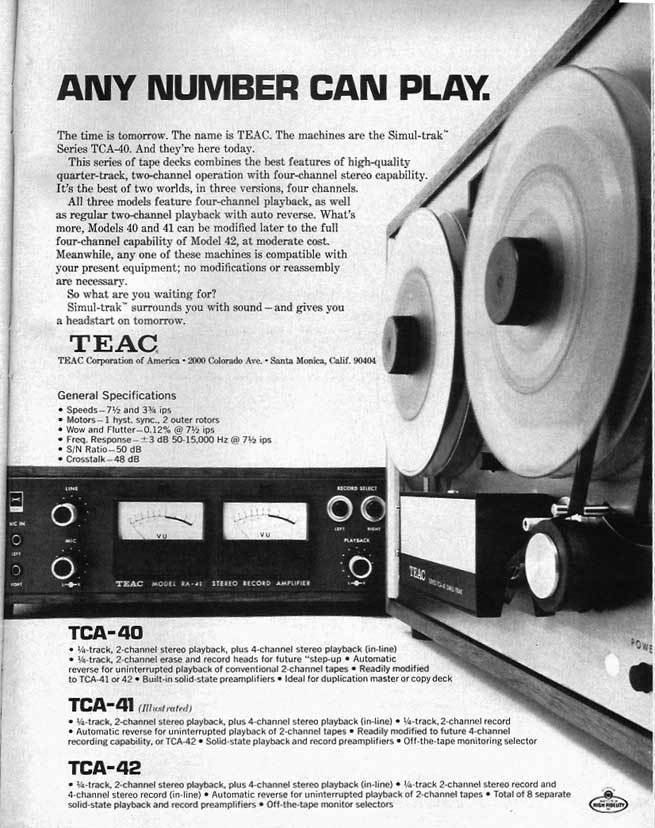
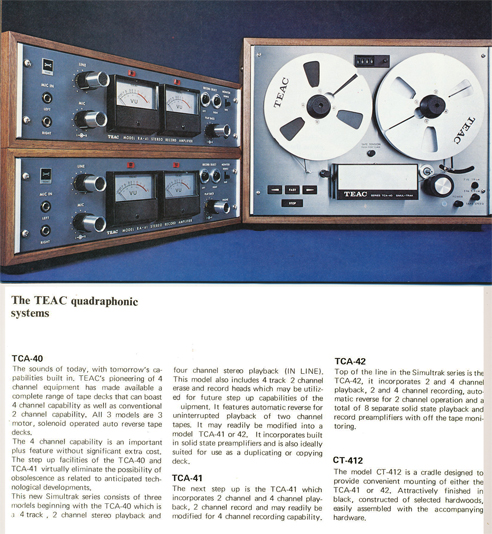

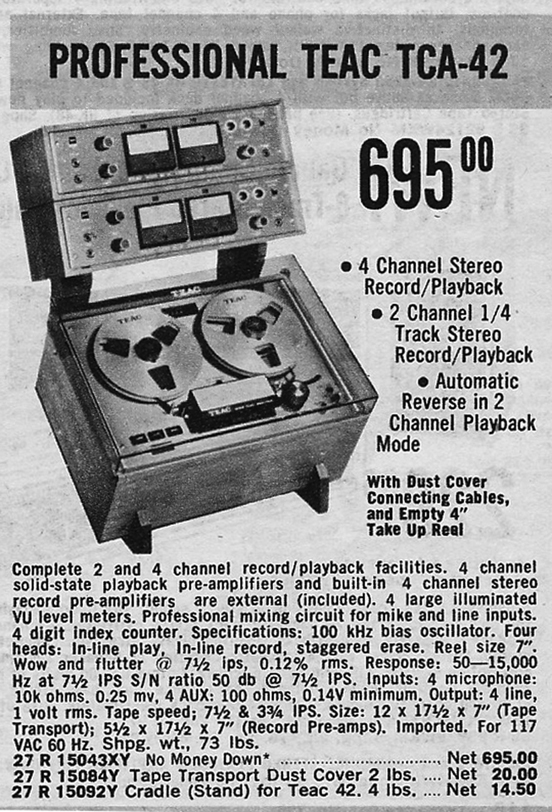
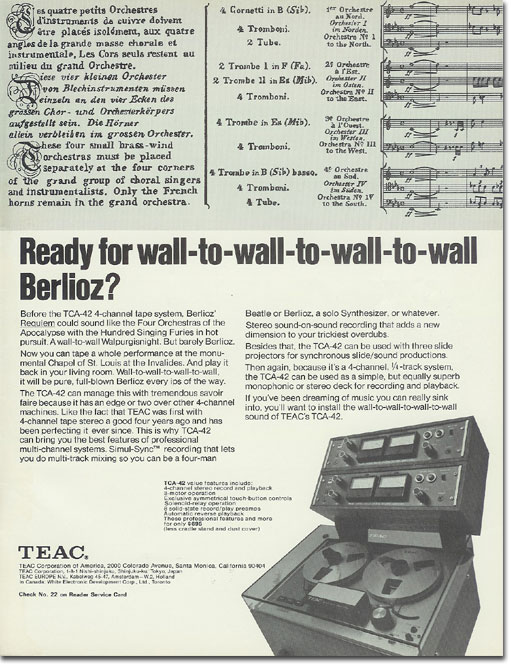
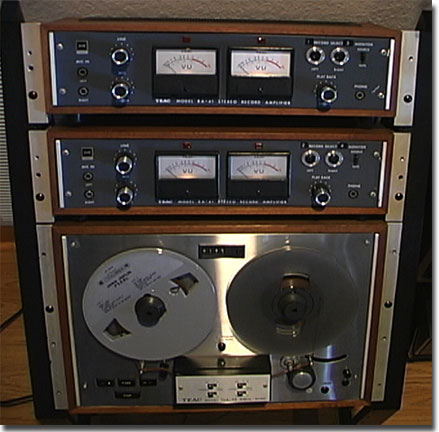
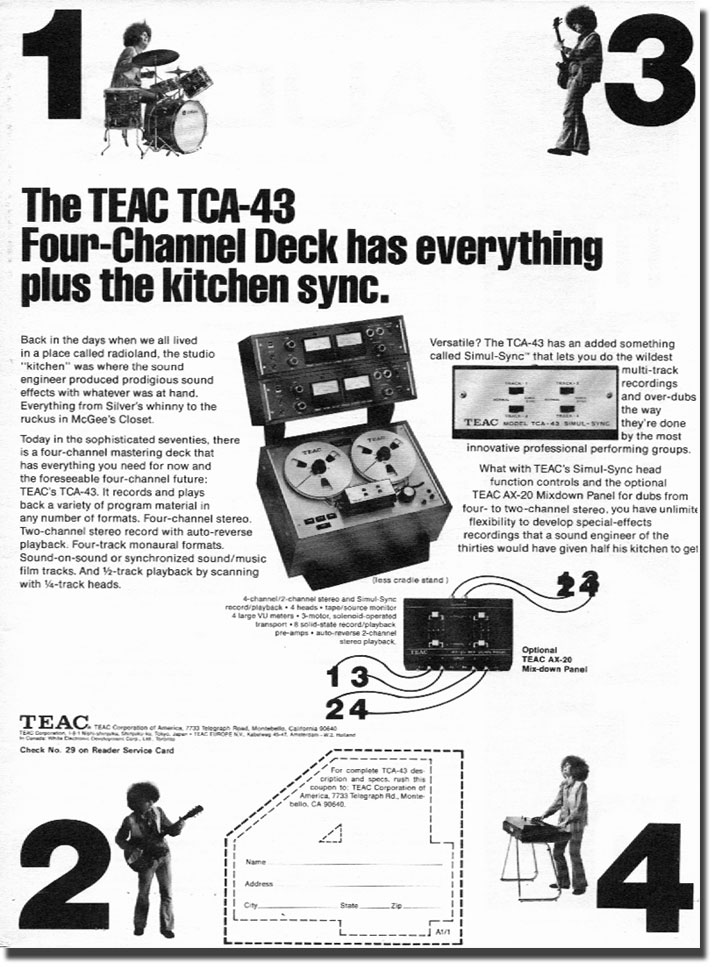
This is the Teac TCA-43 in the Phantom Productions, Inc.'s Reel2ReelTexas.com
The Advent of the Multi-Track
Simul-Sync: the ability to record on one track while listening to another, and the basis for all modern overdubbing technologies.
1972 The first mass-produced 4 channel tape recorders with Simul-Sync, the Teac A-3340S and the Teac A-2340S, are shipped . Teac also releases many other models
1973 The first TASCAM branded products are introduced at the AES (Audio Engineering Society) show held in New York at the Waldorf Astoria. The models introduced are the M-10 mixer, Series 70H-X MTR, Series 70H-8 MTR.
On March 4th, TEAC Corporation of America's eleven directors sign closing documents merging the TASCAM Corporation into TCA (TEAC Corporation of America). TEAC-Japan obtains the exclusive worldwide rights to the TASCAM brand name. The first TASCAM branded products (M-10 mixers) are shipped to dealers. 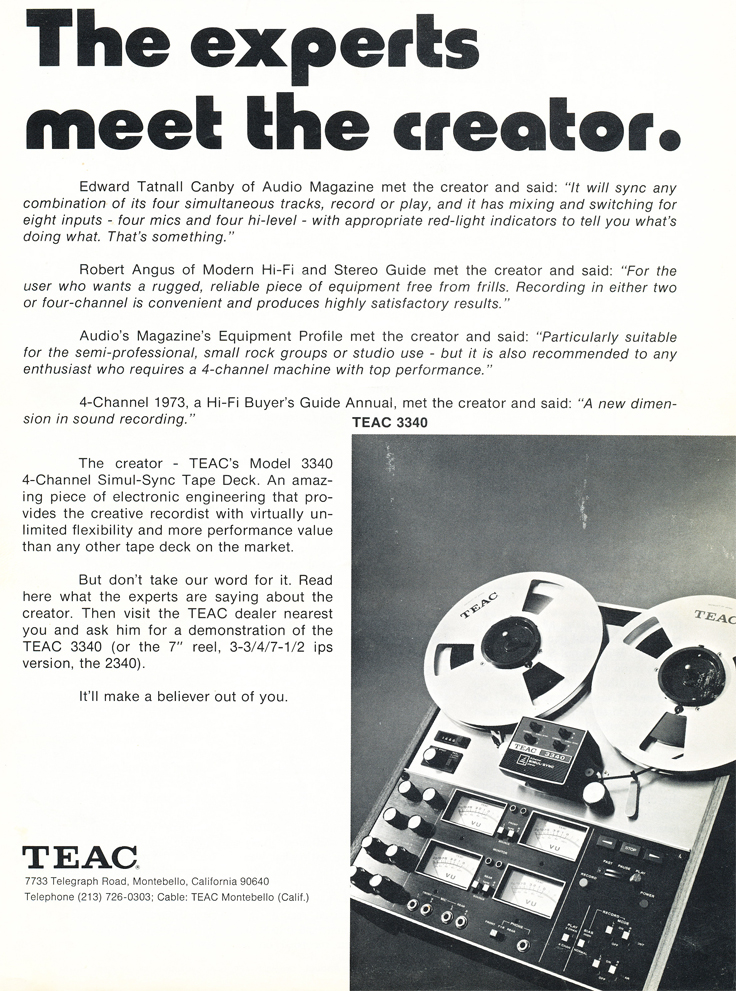
In order to get a clear the advent of multitrack recording with regards to TASCAM, we must first begin our journey prior to 1974 with the introduction of products manufactured under the TEAC brand name. These products were:
(1) The TEAC A-3340 was built specifically as a quadraphonic recorder. However, musicians were instantly attracted to the A3340because of its low price and ability to record four tracks. This was fortunate for TEAC, as quadraphonic playback never caught on to the degree the consumer audio industry pundits had predicted. Dr. Abe and several TEAC employees in the United States quickly grasped the incredible potential of the A3340 as a multitrack recorder, and developed the Simul-Sync technology for the A3340S. This technology enabled the record head to also act as a play head, thus 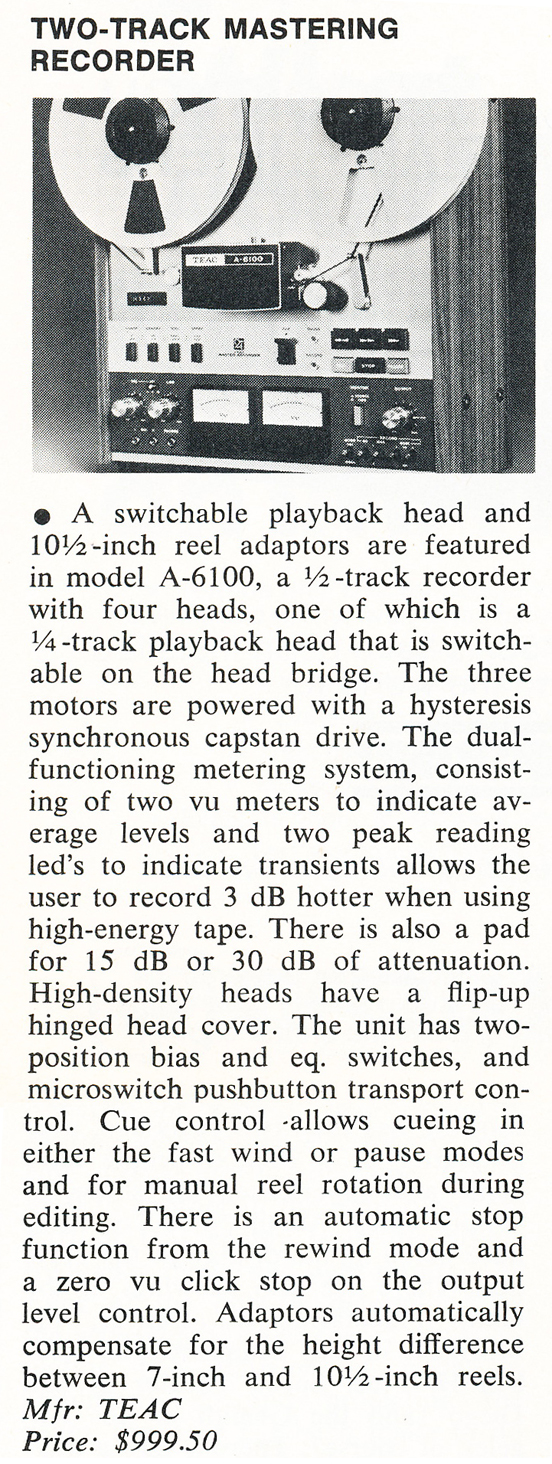 eliminating the delay time between playback and recorded tracks which occurred when record and play heads were physically separated.
eliminating the delay time between playback and recorded tracks which occurred when record and play heads were physically separated.
Even though the TEAC A-3340S was not originally intended for use in a professional environment, its versatility and performance made it a huge success and cemented demand for this affordable multitrack technology. This model was the foundation upon which TASCAM's multitrack business was built.
(2) The TEAC A-6100 (a 1/4 inch 2 track reel-to-reel mastering tape recorder with Simul-Sync). One of the key features of the TEAC A-6100 was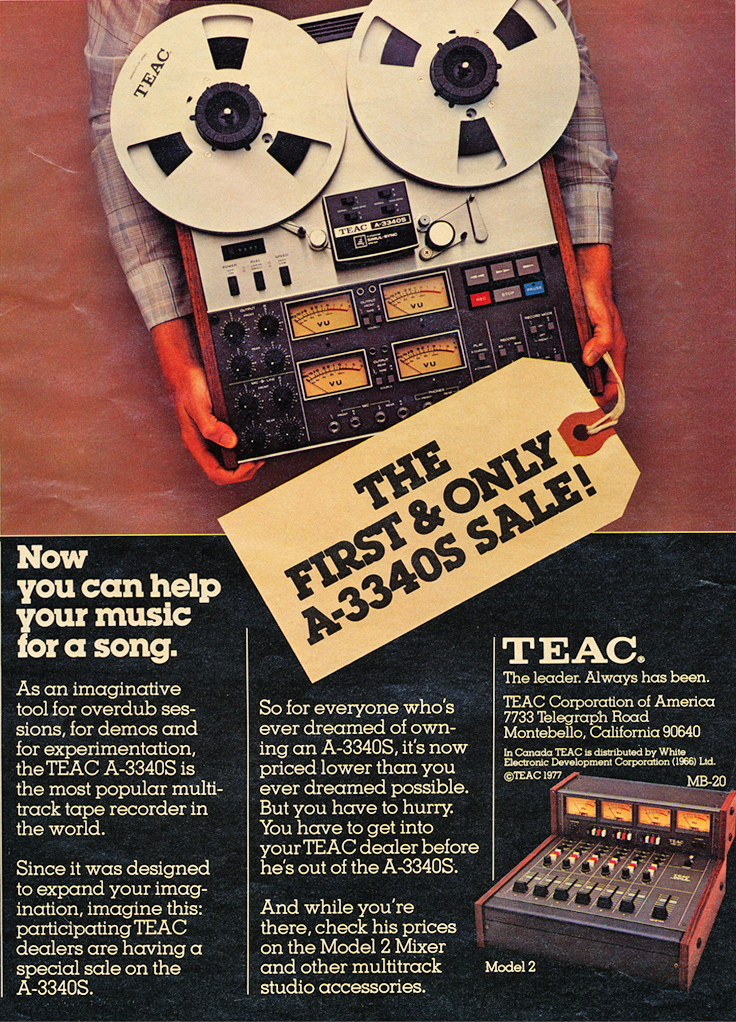 its rugged and durable transport. This product was significant as it was to become the basis for the very successful TASCAM 80-8 recorder.
its rugged and durable transport. This product was significant as it was to become the basis for the very successful TASCAM 80-8 recorder.
(3) The TEAC Model 2 audio mixer featured six pan pots and four full size VU meters.
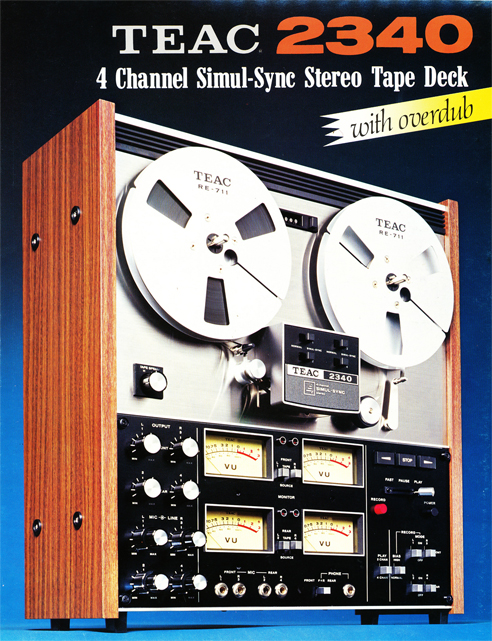 (4) The TEAC A-2340S (a 1/4 inch 4 track multitrack reel-to-reel tape recorder with Simul-Sync with 7 inch reels). The A-2340S was simply a less expensive version of the A-3340S.
(4) The TEAC A-2340S (a 1/4 inch 4 track multitrack reel-to-reel tape recorder with Simul-Sync with 7 inch reels). The A-2340S was simply a less expensive version of the A-3340S.
Several other smaller companies were manufacturing similar types of products, but TEAC was the only company that could design, manufacture and maintain quality of these types of products at a price considerably less than the "pro" studio products.
The original Teac A-2340 and A-3340 had chrome knob covers and in the later upgraded Teac A-2340 and A-3340 reel tape recorder versions, the knobs were all black.
THE FIRST TASCAM PRODUCTS
The Series 70 8 track professional reel tape recorder (below) in the Phantom Productions, Inc.'s Reel2ReelTexas.com
1974 - The first TASC Series 70 reel-to-reel recorders were shipped to dealers in the United States. Originally manufactured 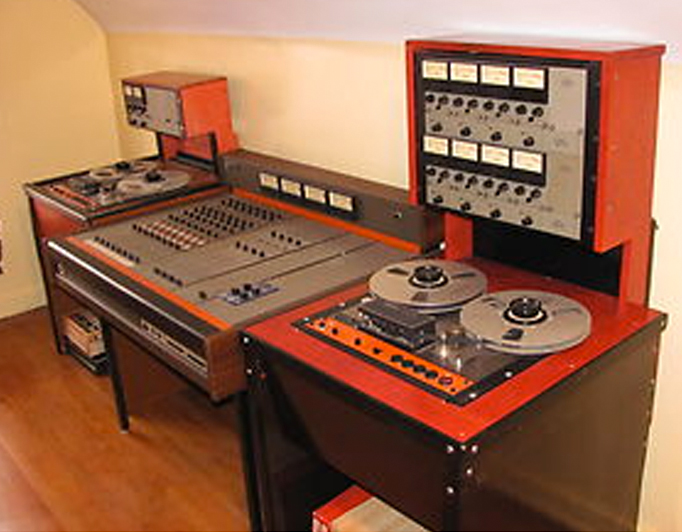 in Japan under the brand name TASC, the recorders were rebranded under the TASCAM name. (The transport for the Series 70 recorders were based on TEAC's A-7030 transport.) There were four 70 series products:
in Japan under the brand name TASC, the recorders were rebranded under the TASCAM name. (The transport for the Series 70 recorders were based on TEAC's A-7030 transport.) There were four 70 series products:
1) 2 track, 1/4 inch master recorder
2) 4 track 1/4 inch reel-to-reel
3) 4 track 1/2 inch reel-to-reel
4) 8 track 1/2 inch reel-to-reel
Introduction of the first TASCAM mixing console, the Model 10, which offered features found in far more expensive mixers. One unique feature of the Model10 (8x4) mixer was that it was designed to be expandable. Featuring a Quad panner, used for Quadraphonic mixing and priced at a very affordable $2,350.00, the Model 10 would change the way the industry would view mixing consoles forever. Its functionality and price point drew the attention of musicians, television post professionals and die-hard audiophiles overnight. The Model 10 became the basis for the Model 5 mixing system.
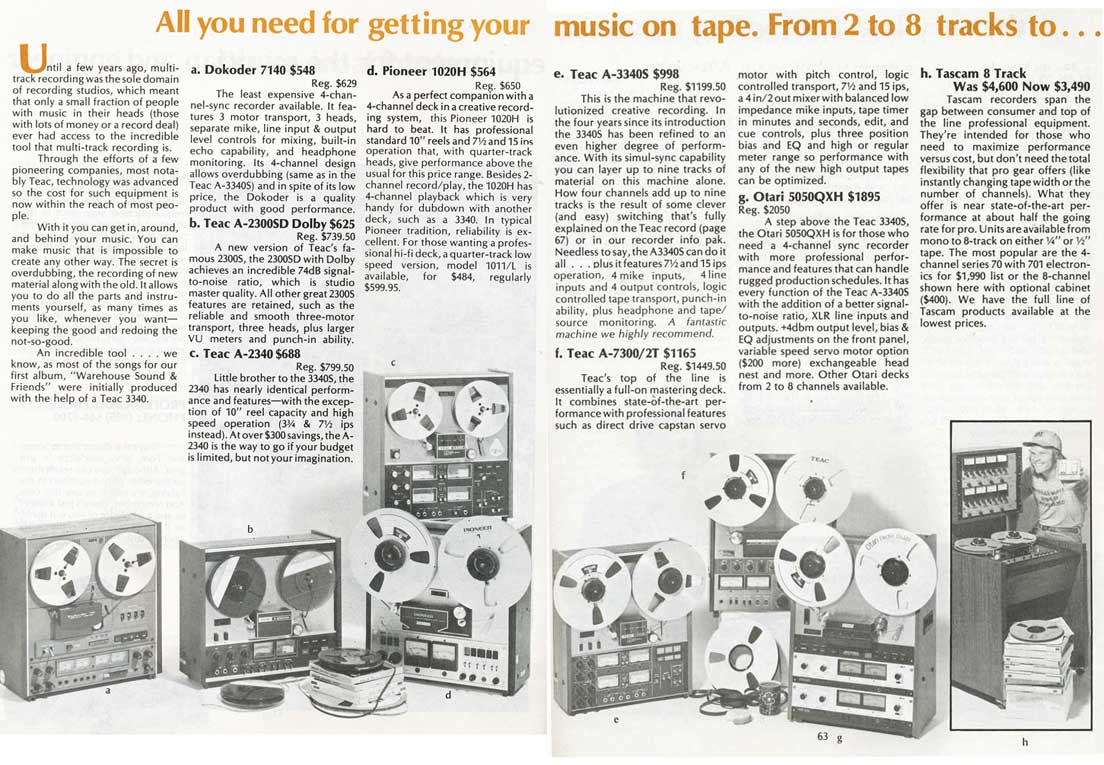
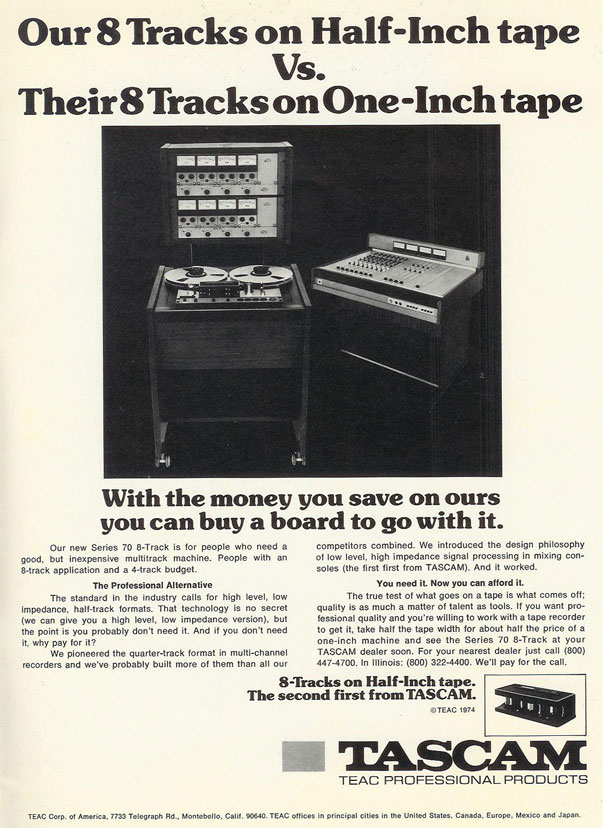
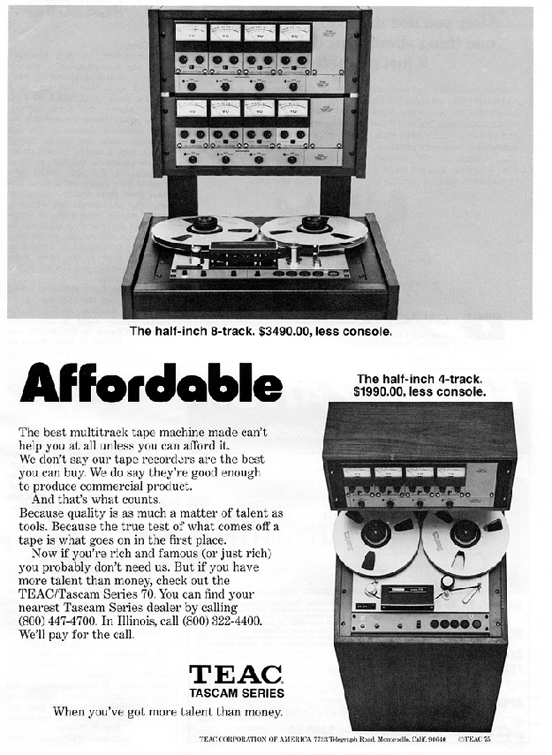

TASCAM relocated its headquarters to 7733 Telegraph Road, Montebello (Los Angeles), California, where it remains to this day.
1975 In September, the long awaited TASCAM series Model 5 mixer (8x4x4), was shipped in limited quantities to excited dealers across the United States. 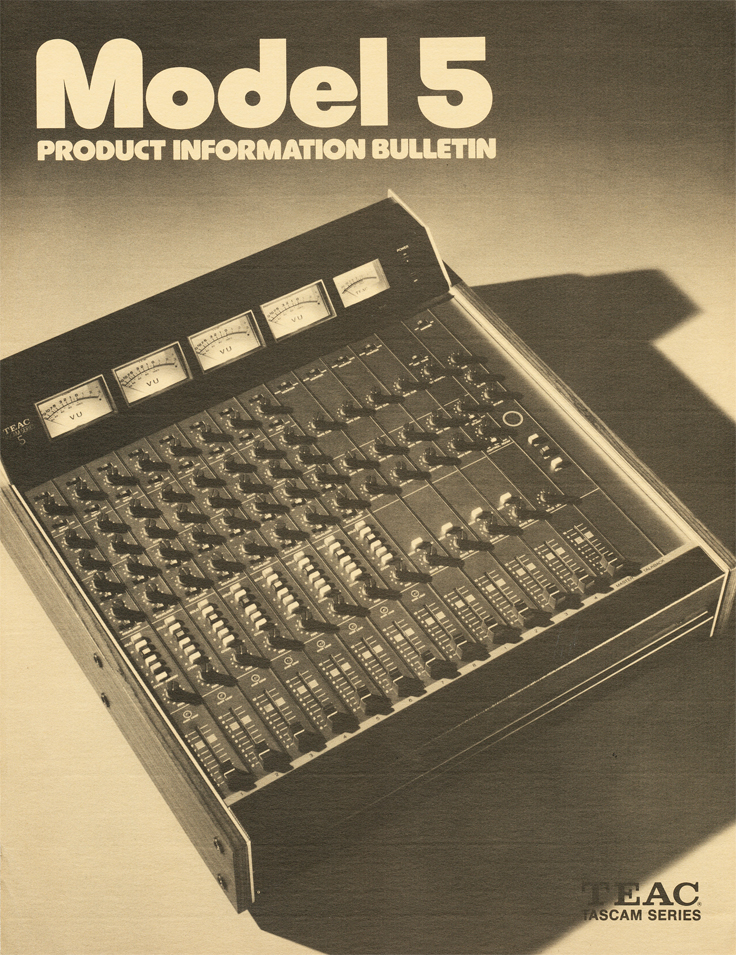 The Model 5 had all the features of the Model 10. Its success in the marketplace was attributed to the fact that it was quieter, considerably less expensive than the Model 10, and was designed to give musicians the same precise control over their sound during a live performance as they had in a controlled recording environment. (List price $1,500.00)
The Model 5 had all the features of the Model 10. Its success in the marketplace was attributed to the fact that it was quieter, considerably less expensive than the Model 10, and was designed to give musicians the same precise control over their sound during a live performance as they had in a controlled recording environment. (List price $1,500.00)
TASCAM ran its first full-page advertisement in November's issue of Rolling Stone Magazine. The advertising message targeted small studio business owners.
In November, TASCAM changed its calibration tape for all TASCAM 70 Series recorders from Scotch 250 to AMPEX 456 Grand Master.
Although short lived, the Series 70 was the first 1/2" multitrack in existence. It paved the way for the 80-8. Introduced into them ark et place in January
Sometime between the Series 70 and the 80-8, Teac Tascam released a Tascam Series 80 (below) professional reel to reel tape recorder which was similar to the Series 70.
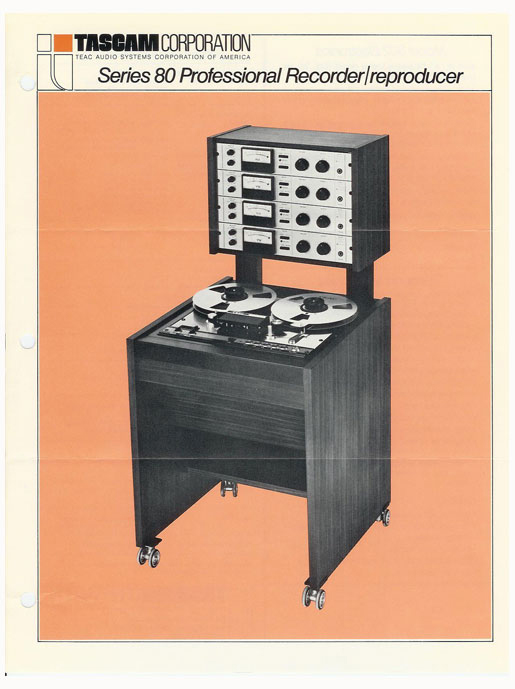

Teac and Ampex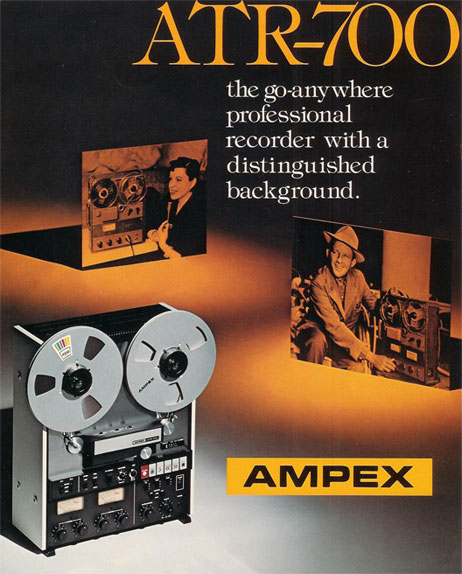
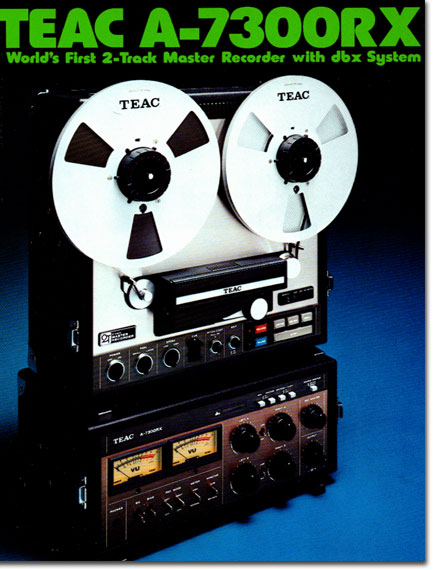
In 1975 Teac released the A-7300 2T 2 Track mastering tape recorder with dbx. Teac manufactured this same unit for Ampex and to Ampex specifications as the Ampex ATR-700 professional reel tape recorder. This was the first known joint manufacture of a reel tape recorder by Ampex and Teac. Later Teac produced the last Ampex reel tape recorder which was the ATR-800. This recorder was styled after the Ampex ATR-100 series professional reel tape recorders.
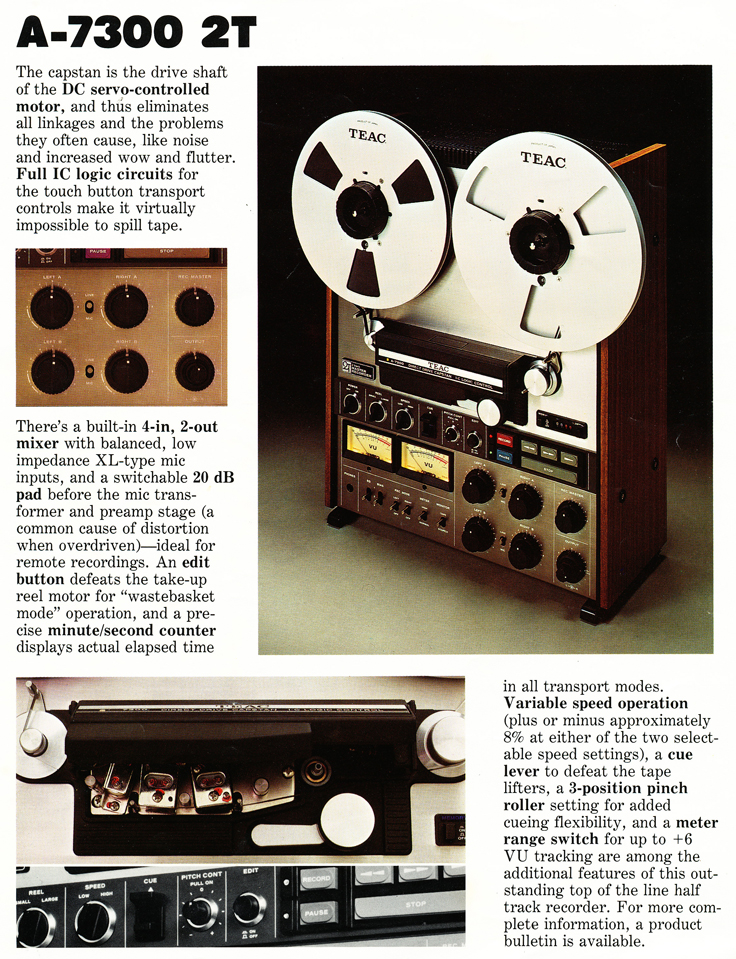
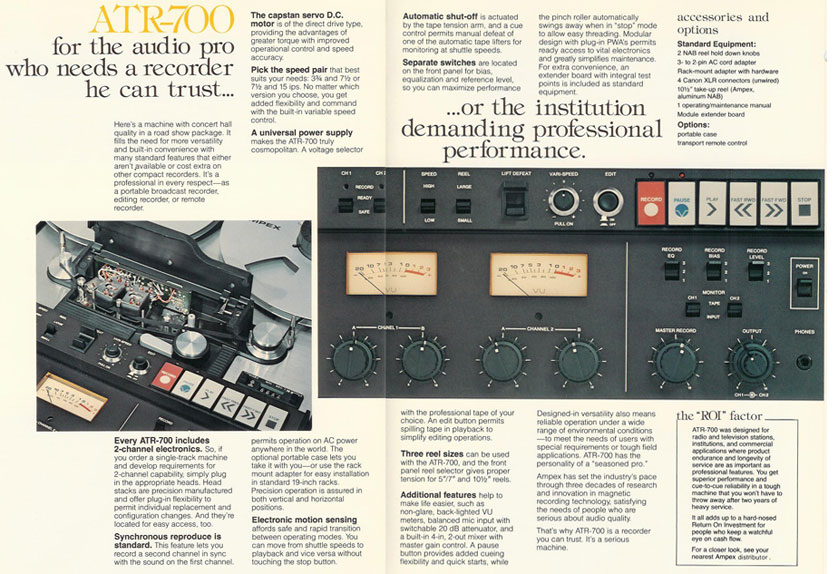
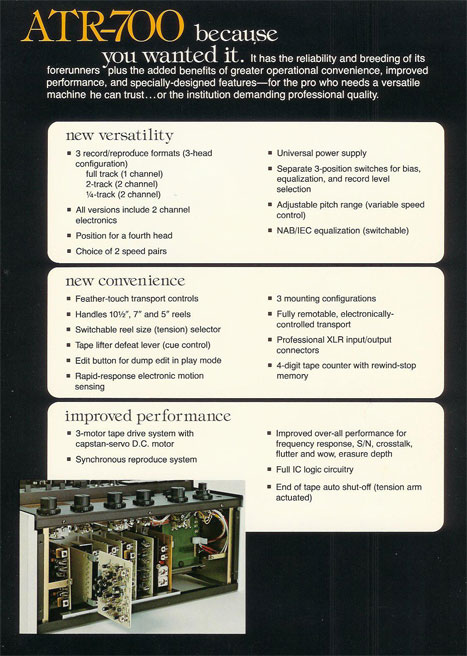
1976 the durability and performance of the 80-8 1/2" 8 track reel-to-reel tape recorder squelched any remaining myths about the viability of affordable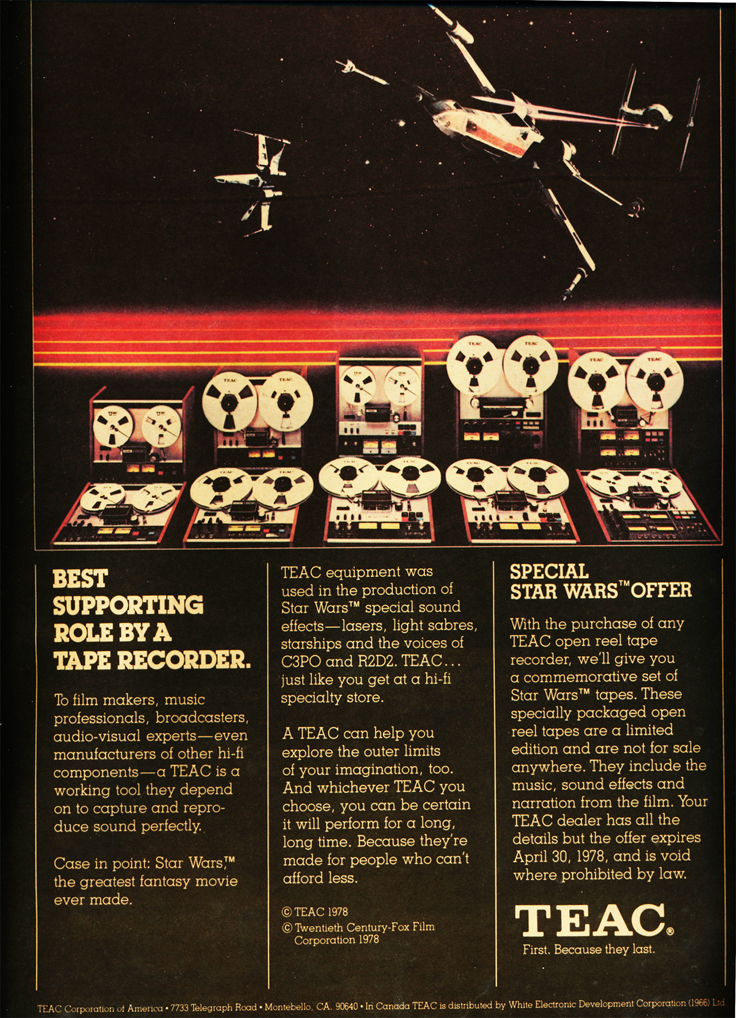
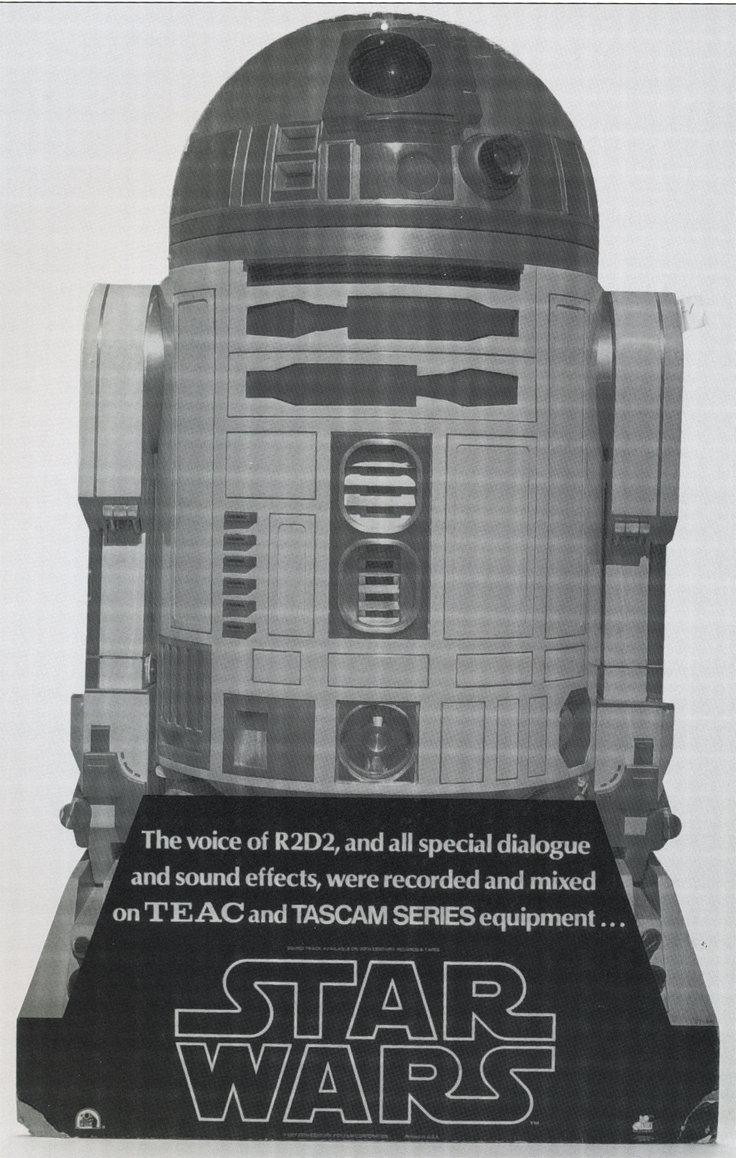 multitrack recording equipment. The 80-8 utilized the same transport as the TEAC A-6100 but boasted more durable motors, a better configuration of the tape path, and greater tolerance under prolonged use and stress.
multitrack recording equipment. The 80-8 utilized the same transport as the TEAC A-6100 but boasted more durable motors, a better configuration of the tape path, and greater tolerance under prolonged use and stress.
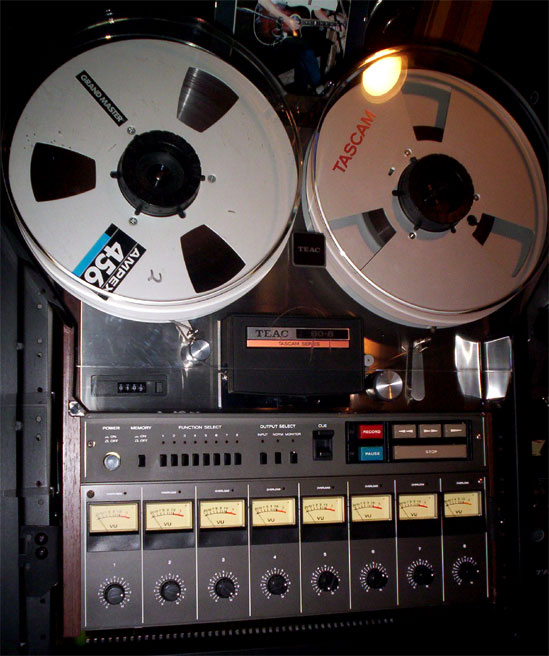 The 80-8 was simple to align. Unlike the Series 70 recorders, all the adjustments could be made from the front of the recorder. Print advertising, the RIAA and Modern Recording and Mix Magazine's support of the 80-8 played a significant part in the ultimate success of this TASCAM product. Classic groups of the mid-70s like Boston and Kansas recorded hit albums using the 80-8 recorder. The Teac/Tascam 80-8 reel tape recorder also became a star in the Star Wars film as it was used to record the audio tracks for R2D2 and 3CPO (see ads right).
The 80-8 was simple to align. Unlike the Series 70 recorders, all the adjustments could be made from the front of the recorder. Print advertising, the RIAA and Modern Recording and Mix Magazine's support of the 80-8 played a significant part in the ultimate success of this TASCAM product. Classic groups of the mid-70s like Boston and Kansas recorded hit albums using the 80-8 recorder. The Teac/Tascam 80-8 reel tape recorder also became a star in the Star Wars film as it was used to record the audio tracks for R2D2 and 3CPO (see ads right).
The TASCAM 80-8 (left in Phantom Productions, Inc.'s Reel2ReelTexas.com) originally sold for $3,500.00. By comparison, an Ampex 8 channel multitrack recorder sold for approximately $10,000.00 at the time.
Introduction of the Model 1 (right), TASCAM's first (8x2) line level mixer.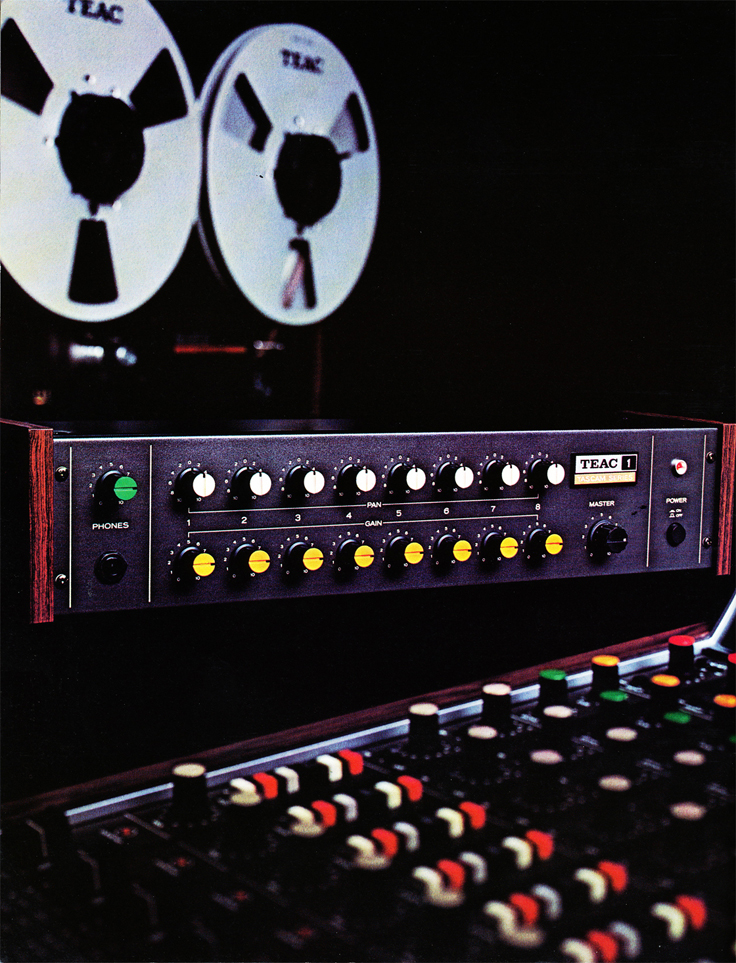
Introduction of the Model 3, TASCAM's 8-In, 4-out 2 Monitor (8x4x2) first versatile and portable mixer.
 TASCAM introduced the rack mountable DX-8 (8 channels of dbx noise reduction). The DX-8 significantly improved the fidelity of audio recordings. When combined with TASCAM's 80-8 multitrack recorder, the marked improvement of the audio mirrored those recordings made on multitrack recorders costing four times as much as the 80-8.
TASCAM introduced the rack mountable DX-8 (8 channels of dbx noise reduction). The DX-8 significantly improved the fidelity of audio recordings. When combined with TASCAM's 80-8 multitrack recorder, the marked improvement of the audio mirrored those recordings made on multitrack recorders costing four times as much as the 80-8.
The DX-8 (dbx noise reduction module) would help TASCAM ultimately level the playing field with regards to its acceptance of a professionally recorded product on an affordable multitrack recorder.
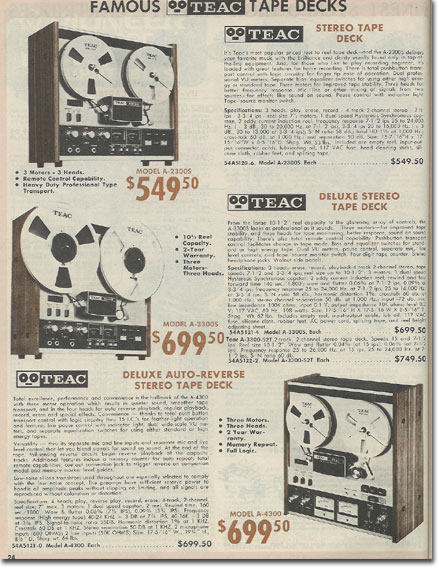
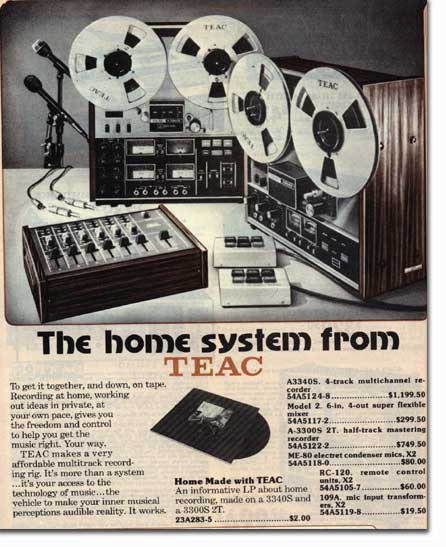
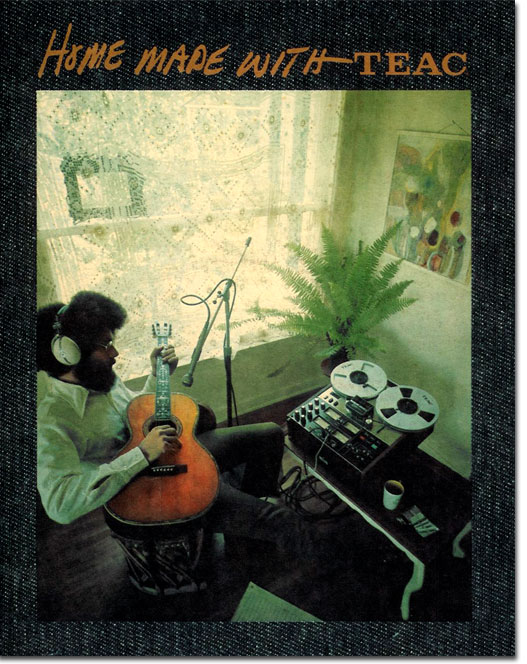
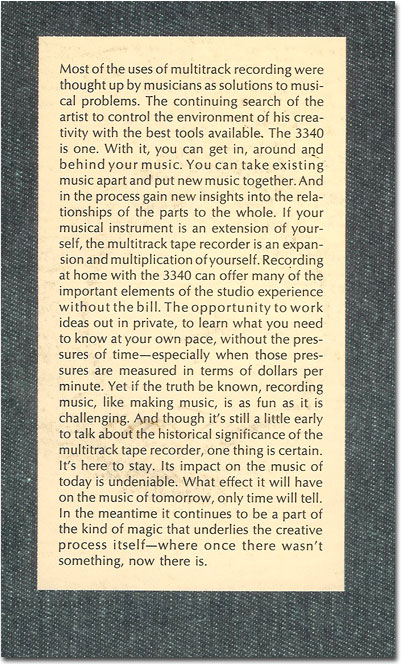
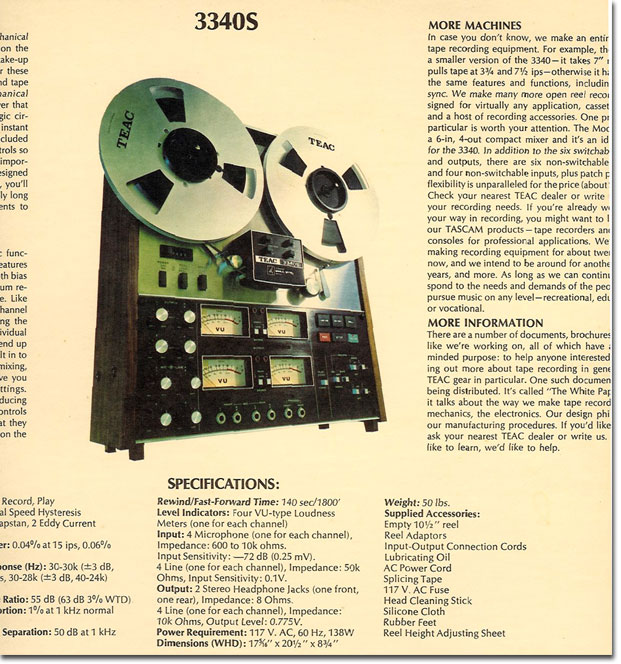
Teac released the album "Home Made with Teac" in 1976" The album was recorded using the Teac A-3340 reel tape recorder
1977 The ideal combination of the 80-8 multitrack tape recorder and the Model 5 portable mixer paved the way for the introduction of the 25-2, a 2 track mastering reel-to-reel recorder far superior to the earlier TASCAM Series 70, 2-track recorders. This 25-2 was also based on the Teac A-7300 and Ampex ATR-700. The 25-2 had what industry professionals touted as being all the right ingredients... quality, durability, aesthetics and most importantly a very reasonable price. The 40-4 was TASCAM's first professional heavy-duty production and playback 1/4" 4 track recorder.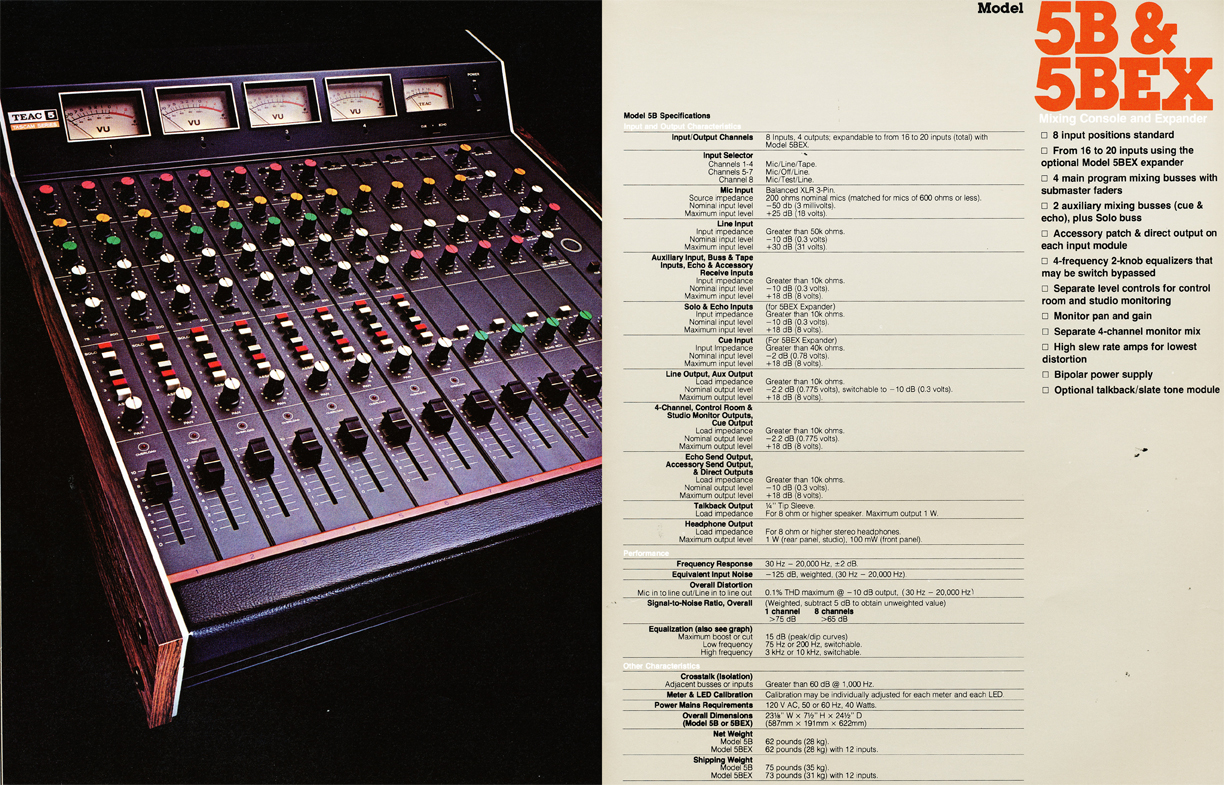
1978 TASCAM introduced its most functional and professional mixer up to that point in its history, the Model 15. There were two versions: (16-in, 8-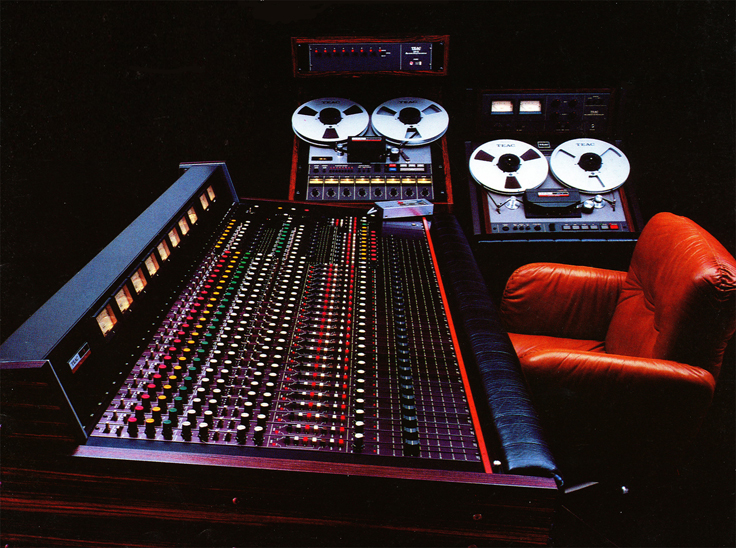 out) and (24-in,8-out). The Model 15 had a width of 61.5 inches, a shipping weight of almost 400 pounds and was priced at $7,500...substantially less than its nearest competitor boasting similar features.
out) and (24-in,8-out). The Model 15 had a width of 61.5 inches, a shipping weight of almost 400 pounds and was priced at $7,500...substantially less than its nearest competitor boasting similar features.
- The Model 5B mixer incorporated a new Integrated Circuit (IC) chip which was four times faster than the previous Model 5 and offered a cleaner sound.
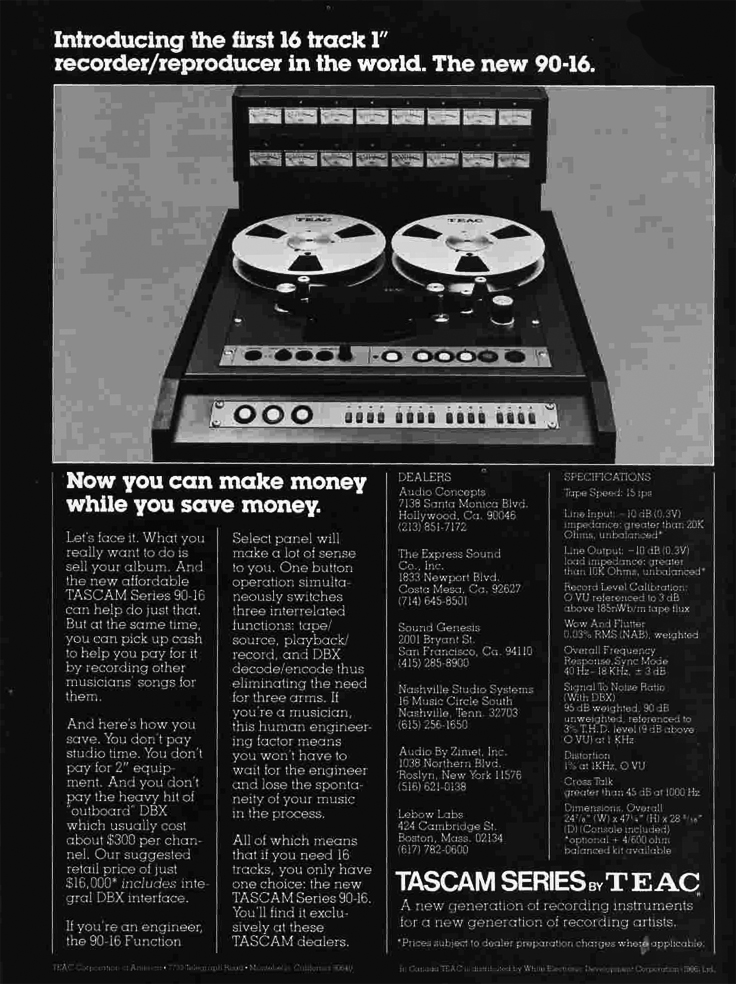
1979 TASCAM unveiled the 90-16, a 1", 16-track multitrack recorder with 16 channels of dbx. This was TASCAM's first 1", 16-track recorder. Its inception paved the way for the genesis of more 16-track studios than ever before, many of which also installed the Model 15 mixers. Designed for ease of operation, the 90-16 featured one button operation which could simultaneously switch three interrelated tape functions: tape/source, playback/record and dbx decode/encode functions. At the time every other 16-track recorder was using 2" tape.
1979 also saw the introduction of a product called the TEAC 124 Syncaset. The key to its success was that its Simul-Sync feature gave musicians the ability to do sound-on-sound on a standard stereo cassette. A musician could listen to one track and overdub on the other at the same time. The 124 carried the TEAC brand name but was marketed by TASCAM's sales organization.
Teac Tascam Part 1 of 3 • Go to Part 2 • Go to Part 3